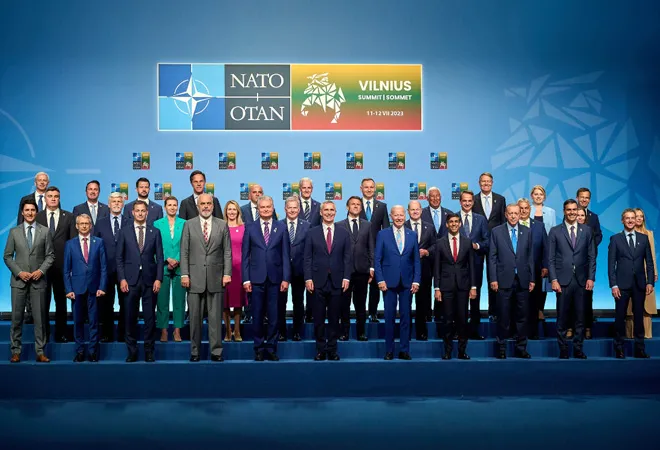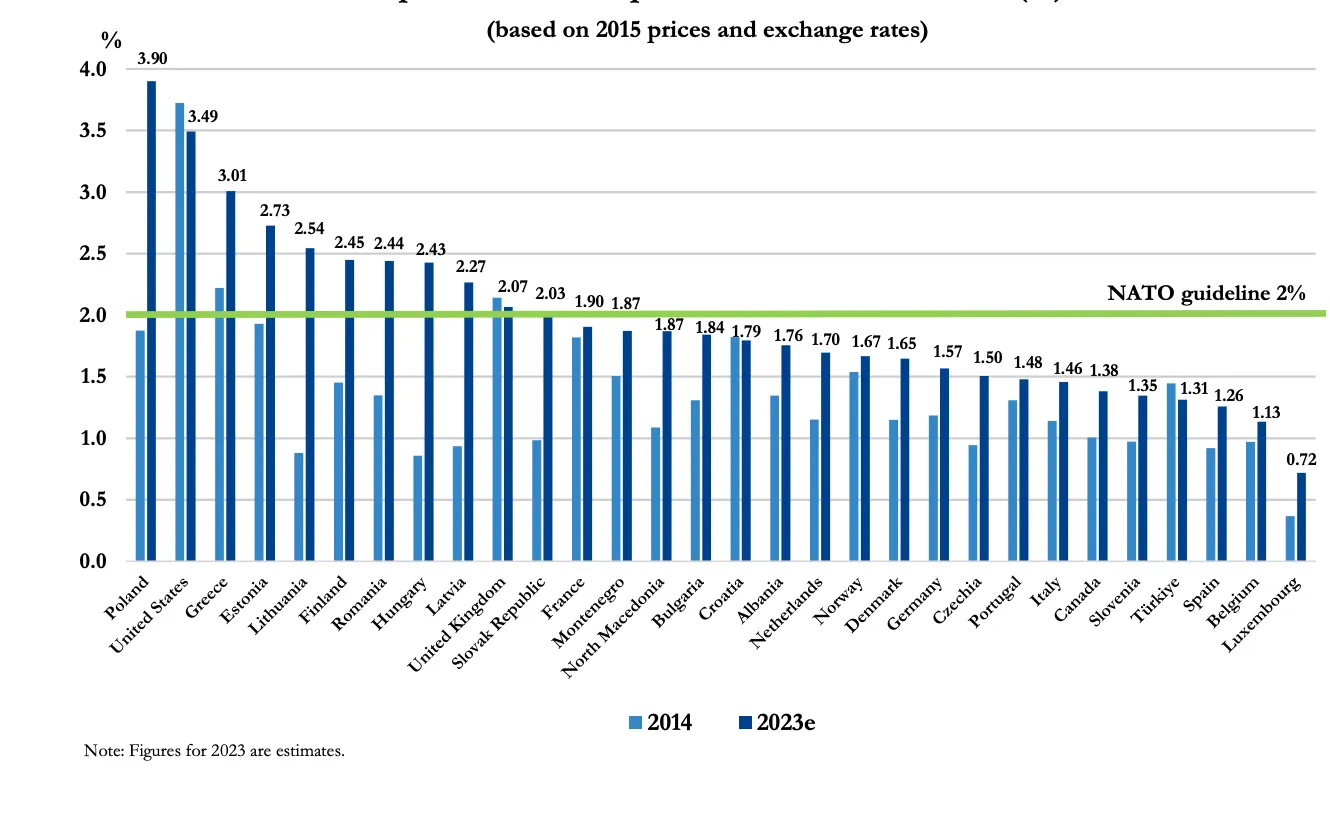
Following the Madrid Summit of 2022 when the allies agreed on new force models and adopted a Strategic Concept to drive the alliance over the next decade—the Vilnius Summit of 11-12 July 2023 appeared to be evaluating the North Atlantic Treaty Organization’s (NATO) progress in the past year and preparing it for any future conflict. While there were high expectations regarding the declaration of a timeline for Ukraine’s membership, the Summit fell short on the issue. However, between the NATO communique and G7 joint declaration, what was clear was that alliance members have doubled down on their commitments towards Ukraine and were working toward enhancing their resilience. This article looks at the key takeaways of the summit.
The Baltic Sea finally becomes the ‘NATO lake’—the Summit was Finland’s first as a NATO member and Türkiye agreed to ratify Sweden’s bid to join the alliance—paving the way for a strategic recalibration in the region that was once dominated by Moscow.
Key takeaways of the summit
First, NATO in its
communique acknowledges that “the Russian Federation is the most significant and direct threat to Allies’ security, peace, and stability in the Euro-Atlantic area.” Their approach towards strengthening their defences and deterrence against Moscow remains the recurring theme of the Summit document. However, two interesting developments include: first, the inclusion of NATO’sconcerns regarding the role played by Belarus and Iran. It calls out Minsk for providing its “territory and infrastructure to allow Russian forces to attack Ukraine and sustain Russia’s aggression”. Referring to the recent developments in Russia, it also expresses concern over the potential deployment of “so-called private military companies”. Another critical reference is to Iran’s deliveries of Uncrewed Aerial Vehicles (UAVs) to Russia which have been used to attack critical infrastructure in Ukraine.
Second, the Baltic Sea finally becomes the ‘NATO lake’—the Summit was Finland’s first as a NATO member and Türkiye agreed to ratify Sweden’s bid to join the alliance—paving the way for a strategic recalibration in the region that was once dominated by Moscow. In a
press statement on 10 July 2023, Türkiye declared its intent to submit the accession protocol to its national assembly for ratification. It also identified that since the Madrid Summit of 2022, Sweden has worked to address the security concerns of Ankara and has amended its Constitution to expand its counter-terrorism cooperation against the PKK, and resumed arms exports to Türkiye. However, if looked closely, President Erdoğan also walked away with substantial concessions including the establishment of the post of Special Coordinator for Counter-Terrorism—a first for NATO; tougher action against the Turkish Kurds in Sweden; restarting conversations with the United States (US) on the delivery of the F-16s; and most surprisingly, President Erdoğan’s emphasis on renewing Türkiye’s aspirations for the European Union (EU) accession, which has been stalled since 2016.
The G7 also doubled down on its commitments towards Kyiv with a joint declaration of an international framework for the long-term security of the country.
Third, there was an expectation of a timeline for the Ukrainian membership of NATO, however, it did not come to pass, instead, the leaders
reiterated that “we will be in a position to extend an invitation to Ukraine when allies agree and conditions are met.” While President Zelensky called the lack of a timeline for the membership “
unprecedented and absurd”—there were already signs that no such commitments would be provided. President Biden
in an interview on 9 July 2023 had remarked that Ukraine was not ready for NATO membership adding that the war “needs to end before the alliance can consider adding Kyiv to its ranks”. Even Germany had
expressed concerns over giving concrete timelines to Ukraine while the conflict was ongoing. Despite no timelines, President Zelensky did get some concrete outcomes including the creation of the NATO-Ukraine Council, the dropping of the Membership Action Plan for its NATO membership and the establishment of a multi-year programme to help Ukrainian forces upgrade to Western standards.
Also as part of their “as long as it takes” commitment—
member states like France, Germany, and Norway declared new commitments towards Ukraine’s defence. This included a 686-million euros security package from Germany which included 40 Marder infantry fighting vehicles, 25 Leopard 1 A5 main battle tanks, etc. The Norwegian government pledged additional 2.5 billion kroner (218 million euros), and France committed SCALP long-range missiles to be delivered to Kyiv. The G7 also doubled down on its commitments towards Kyiv with a joint
declaration of an international framework for the long-term security of the country. This included bilateral security commitments to strengthen Ukraine’s economic, technical, and financial capabilities. In terms of security guarantees, it included continued assistance in terms of modern military equipment, strengthening of Ukraine’s defence industrial base, and intelligence sharing and training of Ukrainian forces. In return, Ukraine committed to continue with the reform process in governance, law enforcement and judiciary, defence, and military sectors.
Fourth, while the communique and discussions were dominated by the crisis in Ukraine and fortifying the Alliance against Russian aggression; China also featured prominently as a key concern. The
communique reiterates the language adopted by the alliance in Strategic Concept of 2022 where Beijing was called a threat to NATO’s security, interests and values, and further builds on its warning that China remains “opaque about its strategy, intentions and military build-up”. It calls out the deepening strategic partnership between Russia and China and Beijing’s support to Moscow. While the Alliance remains open to constructive engagement with China, however, there is a clear recognition of the challenges posed by Beijing to the Euro-Atlantic allies and the need to boost their resilience and preparedness against China’s coercive actions.
The communique points to expanding NATO’s engagement with Japan, Australia, South Korea, and New Zealand and lays importance on the fact that the security of the Indo-Pacific region is linked to that of the Euro-Atlantic.
Within this, emphasis is also laid on the
Indo-Pacific. Vilnius Summit is the second NATO summit which the allies from the region have participated. The communique points to expanding NATO’s engagement with Japan, Australia, South Korea, and New Zealand and lays importance on the fact that the security of the Indo-Pacific region is linked to that of the Euro-Atlantic. While there was a consensus among the allies on the need to strengthen NATO’s presence and engagement in the region, however, they remained divided over how to go about it. There were expectations of an announcement regarding the establishment of a NATO representative office in Japan during the Summit, however, France
raised concerns arguing that such a move would send wrong signals to China and that this geographical expansion would run the risk of diluting NATO’s focus from its prime theatre, i.e. Euro-Atlantic region.
Fifth is the defence spending and readying the alliance for the future. Defence spending remains a perennial problem for NATO with uneven burden-sharing being the most contentious issue. This had taken a whole new dimension with the Ukraine crisis in 2022 when many of the European countries committed themselves to increasing defence budgets and ramping up their military infrastructure as well as their defence-industrial base. In the
estimates released before the Summit, 11 of 31 allies have crossed the 2 percent of GDP mark, with Poland leading the way (Image 1). While the communique points out that the defence spending has increased in the past few years, however, due to a more ‘contested security order’, expenditure beyond this 2 percent of GDP will be required—thereby emphasising that 2 percent is the base and not the ceiling.
Image 1- Defence expenditure as a share of GDP (%)
 Source: https://www.nato.int/nato_static_fl2014/assets/pdf/2023/7/pdf/230707-def-exp-2023-en.pdf
Source: https://www.nato.int/nato_static_fl2014/assets/pdf/2023/7/pdf/230707-def-exp-2023-en.pdf
Another critical outcome was the Allies reaching an agreement on
regional defence plans to ready the Alliance for any future disruption. While the plans have not been made public, what is understood is that NATO allies must have all planning in place well before a conflict might erupt. This is for the first time since the end of the Cold War, that NATO is putting in place concrete action plans that will help allies to upgrade their forces and increase interoperability. However, two challenges can be foreseen in this—first is the financial implications of the implementation of the regional defence plans. While there has been an increase in defence planning, however, in the long run and to sustain these regional plans, the alliance’s military spending will need to be substantially enhanced; second, it will take time for these plans to be put in place as the allies are already stretched to their limits due to their commitments towards Ukraine. Therefore, for any regional defence plans, their military-industrial base needs to be upgraded along with their increased capacities to handle hybrid warfare.
Conclusion
The Summit was able to deliver some concrete way forward with regard to member states commitments towards Ukraine, defining their new regional defence plans, discussing their concerns over China and sending a strong signal to Russia that NATO stands ready to protect the alliance members. A major outcome was the green-lighting of Sweden’s accession to NATO by Türkiye which further strengthens the Alliance in Northern Europe and sent a signal to Russia that no third country has a say in these deliberations under the
Article X of the founding treaty of NATO.
However, the disappointment was over the lack of concrete measures for Ukrainian membership which points towards the lack of consensus among the allies. Still, Ukraine was able to secure short as well as long-term security commitments from the alliance members. As the fine points of the accession are yet to be worked out—the only issue that was resolved during the Summit was whether Kyiv will become a member of the Alliance—this is a development from the
2008 Bucharest Summit which only acknowledged its Euro-Atlantic aspirations. Still, Vilnius Summit was able to offset some of the disappointment with the declaration of support not only by member states but also by the G7 joint declaration of long-term security support to Kyiv.
Ankita Dutta is a Fellow with the Strategic Studies Programme at the Observer Research Foundation
The views expressed above belong to the author(s). ORF research and analyses now available on Telegram! Click here to access our curated content — blogs, longforms and interviews.



 Following the Madrid Summit of 2022 when the allies agreed on new force models and adopted a Strategic Concept to drive the alliance over the next decade—the Vilnius Summit of 11-12 July 2023 appeared to be evaluating the North Atlantic Treaty Organization’s (NATO) progress in the past year and preparing it for any future conflict. While there were high expectations regarding the declaration of a timeline for Ukraine’s membership, the Summit fell short on the issue. However, between the NATO communique and G7 joint declaration, what was clear was that alliance members have doubled down on their commitments towards Ukraine and were working toward enhancing their resilience. This article looks at the key takeaways of the summit.
Following the Madrid Summit of 2022 when the allies agreed on new force models and adopted a Strategic Concept to drive the alliance over the next decade—the Vilnius Summit of 11-12 July 2023 appeared to be evaluating the North Atlantic Treaty Organization’s (NATO) progress in the past year and preparing it for any future conflict. While there were high expectations regarding the declaration of a timeline for Ukraine’s membership, the Summit fell short on the issue. However, between the NATO communique and G7 joint declaration, what was clear was that alliance members have doubled down on their commitments towards Ukraine and were working toward enhancing their resilience. This article looks at the key takeaways of the summit.

 PREV
PREV


